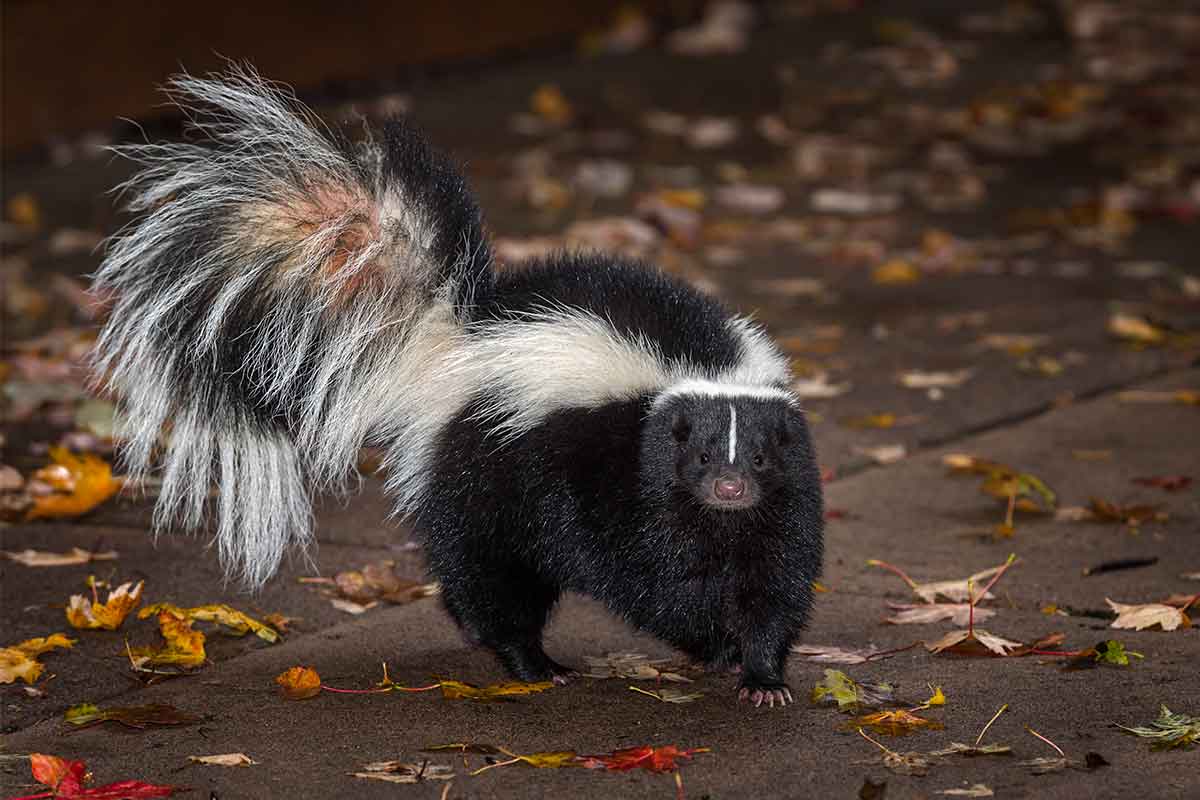If your dog has land to ramble, there’s a good chance he’ll encounter a skunk. City dogs aren’t immune, since wildlife often ignores property boundaries to have babies under your front porch. It’s understandable when clueless dogs get skunked during a close encounter of the stinky kind. But why do they repeat the dirty deed time and again?
My German Shepherd, Magic, has been skunked repeatedly. After the first encounter, my husband learned to leave Magic outside, rather than bring him in to tell me about the smelly situation. Gag! It’s hard enough removing skunk smell from fur, but nearly impossible to eliminate stink from the carpet and upholstery once your stricken dog tries to rub away the smell.
That summer, Magic made it his mission to find skunks on our 13-acre property. Oh, we tried to keep him on leash until the coast was clear, but he’s a determined dog. Magic found skunks five times. Oy!
Why Dogs Can’t Resist Skunks
Magic isn’t stupid, and dogs in general aren’t dumb. So you’d think Magic and his canine compatriots would learn after one or two (or five!) times being nailed by that smelly critter.
It’s not the dog’s fault. Dogs get sprayed repeatedly because they misunderstand skunk language. Here’s what I mean.
Skunks warn potential victims by stomping their feet. If that doesn’t make the dog back off, Mr. Skunk turns around and holds his tail aloft to take aim. Skunks are smart, and don’t want to get the stink on their own fur, but this tail semaphore poised to launch sends a different sort of signal to dogs.
At my house, Magic understands that the cat’s straight-up tail is a friendly greeting display. When dogs meet each other, exchanging butt sniffs is a polite way to make friends. So when skunks turn around and flag their black and white tail, Magic interprets the behavior as the canine equivalent to shaking hands.
Dogs don’t have to get their noses in contact with that tempting tail to get nailed, either. The skunk musk glands on either side of the anus include retractable ducts that can be aimed. They can spray the stink a distance of 10 to 15 feet, so even cautious dogs remain in the line of fire.
I wonder, too, if there might not be some temporary masking of canine scent acuity due to a direct hit. Skunk spray is oily and nearly impossible to remove. It contains thiols, the same types of compounds that create stinky breath or flatulence. A concentration of one in 10 parts per billion can make humans gag, so imagine how that must affect your dog’s sensitive nose.
How To De-Skunk Your Dog
Usually, you’ll need a commercial de-skunking solution that incorporates odor neutralizers specially designed to eliminate skunk smell. It may take repeated baths to make a dent in the stink. Wear comfortable, disposable old clothes and gloves because your dog will transfer odor to you during the bathing process. Trust me on this!
Tomato Juice
This tried and true home remedy can help diminish the stink, but it may turn white dogs pink. Wash the dog first with pet shampoo, towel dry, and then soak him with tomato juice. Let it soak ten or fifteen minutes, rinse, and repeat with the shampoo bath. Alternate the tomato juice soak with the shampoo bath until he’s less pungent.
Massengill Douche
Dog groomers sometimes recommend Massengill brand douche to get rid of skunk odor. You can mix two ounces of Massengill to a gallon of water for the little guys, and double the recipe for big dogs. As with the tomato juice remedy, alternate shampoo with dousing and fifteen-minute soaking with the solution.
Chemistry Cure
A home remedy created by chemist Paul Krebaum can’t be bought, because it explodes if stored in a closed container. His recipe neutralizes thiols that cause the stink. Mix one quart of 3 percent hydrogen peroxide with ¼ cup of baking soda and one teaspoon of pet shampoo (any kind will work). Douse your dog’s wet fur, and let the solution bubble for three or four minutes, then rinse thoroughly.
This article was reviewed/edited by board-certified veterinary behaviorist Dr. Kenneth Martin and/or veterinary technician specialist in behavior Debbie Martin, LVT.








